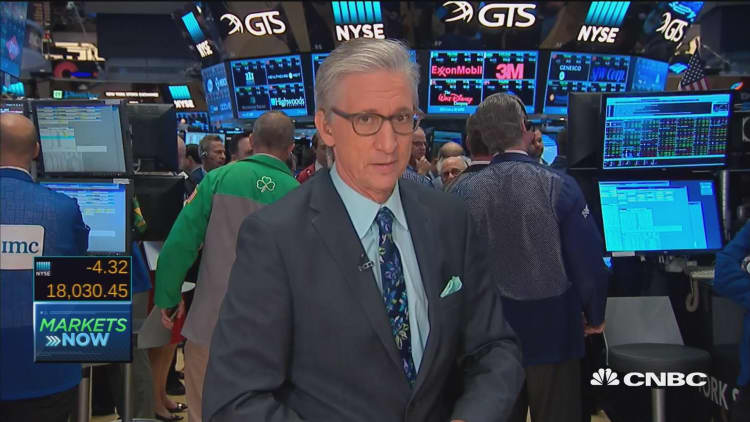
U.S. stocks closed sharply higher on Thursday as investors parsed through a series of economic data as the Federal Reserve's next meeting draws near.
"There are three thing driving today's action," said Michael Arone, chief investment strategist at State Street Global Advisors. "First, Apple is performing better after strong iPhone 7 sales. We've also had a bounce in oil, ... and you've had a number of data that have been tepid at best, and that's making the possibility of a rate hike next week go lower and lower."
The Dow Jones industrial average briefly gained more than 200 points before closing about 180 points higher, with Apple contributing the most gains. The S&P 500 rose 1 percent, with information technology and energy advancing more than 1 percent to lead advancers.
The Nasdaq composite outperformed, rising 1.4 percent, with Apple gaining 3.4 percent. The iPhone maker's stock was up 12 percent for the week and posted its first four-day wining streak with consecutive gains over 2 percent since April 2009.
"I think the market is interpreting the data as it keeping the Fed on the sidelines," said Brent Schutte, chief investment strategist at Northwestern Mutual Wealth Management, but noted that market volatility could increase in the near term. "Typically, when the Fed is at a turning point, volatility picks up. It happened earlier this year and you saw it in 1994."
"I would caution investors to get used to it," he said.
Initial jobless claims came in at 260,000, slightly below expectations, while August PPI came in unchanged, missing expectations. Retail sales for August missed expectations, falling more than expected. Meanwhile, industrial production fell 0.4 percent in August, more than the expected 0.3 percent slide.
"I don't think the numbers were too far off to sway the Fed one way or the other," said Randy Frederick, vice president of trading and derivatives at Charles Schwab. "I don't think we're going to see a major [move] until we get past the Fed."
"Retail sales in August were disappointing," Peter Boockvar, chief market analyst at The Lindsey Group, said in a note to clients. "Bottom line, core sales are up just 2.8% y/o/y which is the slowest pace of gains since March. To put this level into perspective, the 5 yr average is 3.5%. The average seen in the mid 2000's mortgage equity withdrawal bubble was 5.4% and the late 1990's average was 5.6%."
Business inventories for July came in unchanged versus an estimated rise of 0.1 percent.
Thursday's data deluge was the last before the Fed's policymaking committee begins its two-day meeting on monetary policy. Investors have been closely looking at economic data, evaluating the possibility the central bank raises interest rates.
"The Fed has done a great job of confusing the heck out of everybody," said Matt Tuttle, CIO at Tuttle Tactical Management. "I don't think they move [next week]. If they do, I wouldn't be surprised because they've confused everyone so much."
Market expectations for a rate hike this month are just 12 percent after Thursday's data release, according to the CME Group's FedWatch tool.
"I think the Fed is in a lose-lose situation. If they hike, then the market is going to have a problem with that because it hasn't been priced in. If they don't raise after all the hawkish talk we've heard recently, then it raises questions about the Fed's communication strategy," said Steve Chiavarone, portfolio manager at Federated Investors. He also noted the weak retail sales data makes a Fed rate hike next week "even more unlikely."
U.S. futures pared gains after the economic data release. On Wednesday, U.S. stocks closed mostly lower, with the Dow and S&P posting slightly negative sessions while the Nasdaq rose more than a third of a percent, bolstered by strong gains in Apple.
In oil markets, U.S. crude settled 0.8 percent higher at $43.91 per barrel, but gains were capped by returning supply from Nigeria and Libya. Crude prices fell about 3 percent for a second straight day on Wednesday following a 4.6 million barrel build in U.S. distillates inventories. It was the biggest weekly build since January and put distillate stocks at six-year seasonal highs.
Overseas, European equities closed slightly higher after the Bank of England kept interest rates unchanged. The British pound fell 0.1 percent to $1.3240 against the dollar after the announcement. The greenback was slightly lower against a basket of currencies, with the euro near $1.1241 and the around 102.21.
U.S. Treasurys traded mixed, with the two-year note yield lower, around 0.74 percent, and the benchmark 10-year yield higher, around 1.70 percent.
Major U.S. Indexes
The Dow Jones industrial average rose 177.71 points, or 0.99 percent to close at 18,212.48, with Apple leading all components higher.
The gained 21.49 points, or 1.01 percent, to end at 2,147.26, with information technology leading all sectors higher.
The Nasdaq advanced 75.92 points, or 1.47 percent, to close at 5,249.69.
About three stocks advanced for every decliner at the New York Stock Exchange, with an exchange volume of 830 million and a composite volume of 3.29 billion at the close
Gold futures for December delivery settled $8.10 lower at $1,318 per ounce.
The CBOE Volatility Index (VIX), widely considered the best gauge of fear in the market, traded 11.47 percent lower, near 16.06.
—CNBC's Gina Francolla and Reuters contributed to this report.
On tap this week:
*Planner subject to change.
Friday
8:30 a.m. CPI
10:00 a.m. Consumer sentiment
4:00 p.m. TIC data


